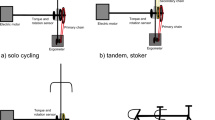Summary
Traction resistance (R t) was determined by towing two cyclists in fully dropped posture on bicycles with an aerodynamic frame with lenticular wheels (AL), an aerodynamic frame with traditional wheels (AT), or a traditional frame with lenticular wheels (TL) in calm air on a flat wooden track at constant speed (8.6–14.6 m·s−1). Under all experimental conditions, R t increased linearly with the square of air velocity (νa 2); r 2 equal to greater than 0.89. The constant k = ΔR t/Δνa 2 was about 15% lower for AL and AT (0.157 and 0.155 N·2·m−2) than for TL bicycles (0.184 N·2·−2). These data show firstly, that in terms of mechanical energy savings, the role of lenticular wheels is negligible and, secondly, that for TL bicycles, the value of k was essentially equal to that found by others for bicycles with a traditional frame and traditional wheels (TT). The energy cost of cycling per unit distance (C c, J·m−1) was also measured for AT and TT bicycles from the ratio of the O2 consumption above resting to speed, in the speed range from 4.7 to 11.1 m·s−1. The C c also increased linearly with νa 2, as described by: C c = 30.8 + 0.558 νa 2 and C c = 29.6 + 0.606 νa 2 for AT and TT bicycles. Thus from our study it would seem that AT bicycles are only about 5% more economical than TT at 12.5 m·s− the economy tending to increase slightly with the speed. Assuming a rolling coefficient equal to that observed by others in similar conditions, the mechanical efficiency was about 10% lower for aerodynamic than for conventional bicycles, amounting to about 22% and 25% at a speed of 12.5 m·s−1. From these data it was possible to calculate that the performance improvement when riding aerodynamic bicycles, all other things being equal, ought to be about 3%. This compares favourably with the increase of about 4% observed in world record speeds (over distances from 1 to 20 km) after the adoption of the new bicycles.
Similar content being viewed by others
References
di Prampero PE (1986) The energy cost of human locomotion on land and water. Int J Sports Med 7:55–72
di Prampero PE, Cortili G, Mognoni P, Saibene F (1979) Equation of motion of a cyclist. J Appl Physiol 47:201–206
Dubois D, Dubois EF (1915) The measurement of the surface area of man. Arch Intern Med 15:868–881
Geigy Scientific Tables (1982) Introduction to statstics, statistical tables, mathematical formulae. In: Lentner C (ed) Ciba-Geigy, Basle, pp 214–215
Kyle C (1979) Reduction of wind resistance and power output of racing cyclists and runners travelling in groups. Ergonomics 22:387–397
Kyle C (1986) Mechanical factors affecting the speed of a cycle. In: Burke ER (ed) Science of cycling. Human Kinetics, Champaign, Ill., pp 133–135
McCole SD, Claney K, Conte J-C, Anderson R, Hagberg J (1990) Energy expenditure during bicycling. J Appl Physiol 68:748–753
Pugh LGCE (1973) The influence of wind resistance in running and walking and the mechanical efficiency of work against horizontal or vertical forces. J Physiol (Lond) 213:255–276
Pugh LGCE (1974) The relation of oxygen intake and speed in competition cycling and comparative observations on the bicycle ergometer. J Physiol (Lond) 241:795–808
Sargeant AJ (1988) Optimum cycle frequencies in human movement. J Physiol (Lond) 241:49P
Seabury JJ, Adams WC, Ramey MR (1977) Influence of pedalling rate and power output on energy expenditure during bicycle ergometry. Ergonomics 20:491–498
Swain DP, Richard Coast J, Clifford PS, Milliken MC, Stray-Gundersen J (1987) Influence of body size on oxygen consumption during bicycling. J Appl Physiol 62:668–672
Welbergen E, Clijsen LPVM (1990) The influence of body position on maximal performance in cycling. Eur J Appl Physiol 61:138–142
Author information
Authors and Affiliations
Rights and permissions
About this article
Cite this article
Capelli, C., Rosa, G., Butti, F. et al. Energy cost and efficiency of riding aerodynamic bicycles. Europ. J. Appl. Physiol. 67, 144–149 (1993). https://doi.org/10.1007/BF00376658
Accepted:
Issue Date:
DOI: https://doi.org/10.1007/BF00376658




